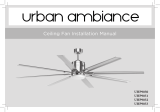
Date d’achat
Magasin
Nº de modèle
Nº de série
Nº du fournisseur
CUP
109226
785247000000
785247000000
Garantie limitée à vie
Progress Lighting garantit à l’acheteur initial que les moteurs de ventilateur sont exempts de défauts électriques ou mécaniques
tant que l’acheteur initial est propriétaire du ventilateur. Les interrupteurs à chaînette, les interrupteurs inverseurs, les
condensateurs et les finis métalliques sont garantis contre les défauts de matériaux ou de fabrication pendant une période d’un
an à partir de la date d’achat. Le gauchissement des pales de bois ou de plastique n’est pas couvert par la présente garantie, ni la
corrosion ou la détérioration du fini des ventilateurs installés à moins de dix milles d’un bord de mer. Les garanties prolongées
pour les produits homologués ENERGY STAR® peuvent s’appliquer.
Lorsqu’ils sont installés correctement et dans des conditions d’utilisation normales, les ventilateurs de plafond Progress
Lighting dotés d’une source lumineuse à DEL intégrée sont garantis contre les défauts de matériaux et de fabrication causant le
non fonctionnement de la source lumineuse selon les spécifications pendant (i) cinq (5) ans à partir de la date d’achat des
modules d’éclairage à DEL et des composants électriques des ventilateurs pour les résidences unifamiliales et (ii) trois (3) ans à
partir de la date d’achat des modules d’éclairage à DEL et des composants électriques des ventilateurs pour les résidences
multifamiliales et pour les utilisations commerciales. Les ampoules à DEL fournies par Progress Lighting ne sont assorties
d’aucune autre garantie que celle du fabricant. Les ampoules autres qu’à DEL ne sont assorties d’aucune garantie.
En fournissant la preuve d’achat, l’acheteur initial peut retourner le ventilateur défectueux à son lieu d’achat pendant les 30
premiers jours afin qu’il soit remplacé. Après 30 jours, l’acheteur initial DOIT communiquer avec Progress Lighting au 864
678-1000 pour la réparation ou le remplacement du ventilateur, ce qui sera déterminé exclusivement par Progress Lighting et
constituera le seul et unique recours de l’acheteur.
Main-d’œuvre et expédition exclus. La présente garantie ne couvre par les coûts et les frais associés à la main-d’œuvre (y
compris, sans s’y limiter, les frais d’électricien) nécessaires à l’installation, au retrait ou au remplacement du ventilateur ou des
pièces du ventilateur.
La présente garantie ne s’applique pas en cas de perte ou de dommage découlant (i) de l’usure normale, de l’altération ou d’un
usage incorrect, abusif ou négligent ou (ii) d’une installation, d’une utilisation, d’une réparation ou d’un entretien inadéquats par
l’acheteur initial ou un tiers, y compris, sans s’y limiter, une tension électrique inadéquate ou une surtension, l’utilisation de
pièces ou d’accessoires inadéquats, une réparation non autorisée (effectuée ou tentée) ou l’omission d’entretenir le ventilateur.
LES GARANTIES QUI PRÉCÈDENT ÉNONCENT L’ENTIÈRE RESPONSABILITÉ DE PROGRESS LIGHTING AU
CHAPITRE DE LA GARANTIE AINSI QUE LE SEUL ET UNIQUE RECOURS DE L’ACHETEUR LIÉ À CES PRODUITS.
PROGRESS LIGHTING N’EST PAS RESPONSABLE DES DOMMAGES (Y COMPRIS LES DOMMAGES INDIRECTS,
SPÉCIAUX, ACCESSOIRES OU CONSÉCUTIFS) ATTRIBUABLES À LA DÉFECTUOSITÉ DU PRODUIT, QU’ILS
SOIENT LIÉS À UNE VIOLATION DE LA GARANTIE, UNE VIOLATION DU CONTRAT OU AUTRE. LA PRÉSENTE
GARANTIE REMPLACE TOUTE AUTRE GARANTIE, EXPRESSE OU IMPLICITE, Y COMPRIS TOUTE GARANTIE
DE QUALITÉ MARCHANDE, D’UTILITÉ À UNE FIN PARTICULIÈRE OU D’ABSENCE DE CONTREFAÇON.
Certains États ne permettent pas de limitation à la durée implicite d’une garantie ou d’exclusion ou de limitation des dommages
accessoires ou consécutifs. Par conséquent, les limitations ci-dessus pourraient ne pas s’appliquer à vous. La présente garantie
vous accorde des droits précis et vous pourriez avoir d’autres droits qui peuvent varier d’un État à l’autre.





























